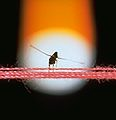Programozó versenyekDEIK Regionális Programozó Csapatverseny, középiskolai kategória, 2014. november 30.
2014. november 30. 10:30 –
2014. november 30. 15:30
|
Kíváncsi bolhák

A legértékesebb tulajdonod egy bolhacirkusz, amelynek a fő attrakcióját hat akrobata bolha előadása jelenti. Egy nap véletlenül feldöntöd a bolhákat tároló dobozt, amelyek így mind leesnek a konyhád padlóját alkotó négyzet alakú csempék 4×4-es hálójára. Meglepő módon mindegyik bolha más-más csempén landol.
Andy fiadnak van egy (hagyományos, hatoldalú) kockája, amely pontosan akkora, mint egy csempe. Elhatározod, hogy játszol egy játékot. Először is lerakod a kockát pontosan egy olyan csempére, amelyen nincs bolha, majd elkezded forgatni a kockát az élein keresztül valamelyik szomszédos csempére. A bolhák nagyon kíváncsiak; szeretnek felfedezni. Ha olyan csempére forgatod a kockát, amelyen van egy bolha, akkor az felugrik a kocka aljára. A bolhák elég kicsik ahhoz, hogy elférjenek a kocka pöttyeinek vájataiban, tehát nem halnak meg a folyamat során. Hasonlóan, ha egy bolha van a kocka azon oldalán, amelyet a padlóra forgatunk, akkor az leugrik a kockáról a csempére.
A játék célja, hogy úgy forgassuk a kockát, hogy végül minden bolha a kockán legyen. A kocka nem hagyhatja el a konyhád 4×4-es csempehálóját. Az első példa bemenet egy lehetséges megoldását szemlélteti az alábbi ábra:

A bemenet specifikációja
A bemenet első sora a tesztesetek számát tartalmazza. Minden teszteset egy üres sorral
kezdődik, amelyet 4 sor követ, mindegyikben 4 karakterrel. Ez a 4 sor a csempék kezdeti
konfigurációját írja le. A „.” egy üres csempét, az
„X” egy bolhát tartalmazó csempét jelöl, a
„D” pedig a kockát tartalmazó csempét adja meg. Minden tesztesetben
pontosan egy „D” és pontosan hat „X”
karakter fog szerepelni.
A kimenet specifikációja
Minden tesztesetre egyetlen sort kell a kimenetre írni egy olyan számmal, amely megadja, hogy
minimálisan hány forgatás szükséges ahhoz, hogy a kocka minden oldalán legyen egy bolha. Ha
egy esetnek nincs megoldása, akkor az „impossible” szót kell kiírni.
Példa bemenet
2...XXXXXD..X....DX.X.X....X.X..X
A példa bemenethez tartozó kimenet
814